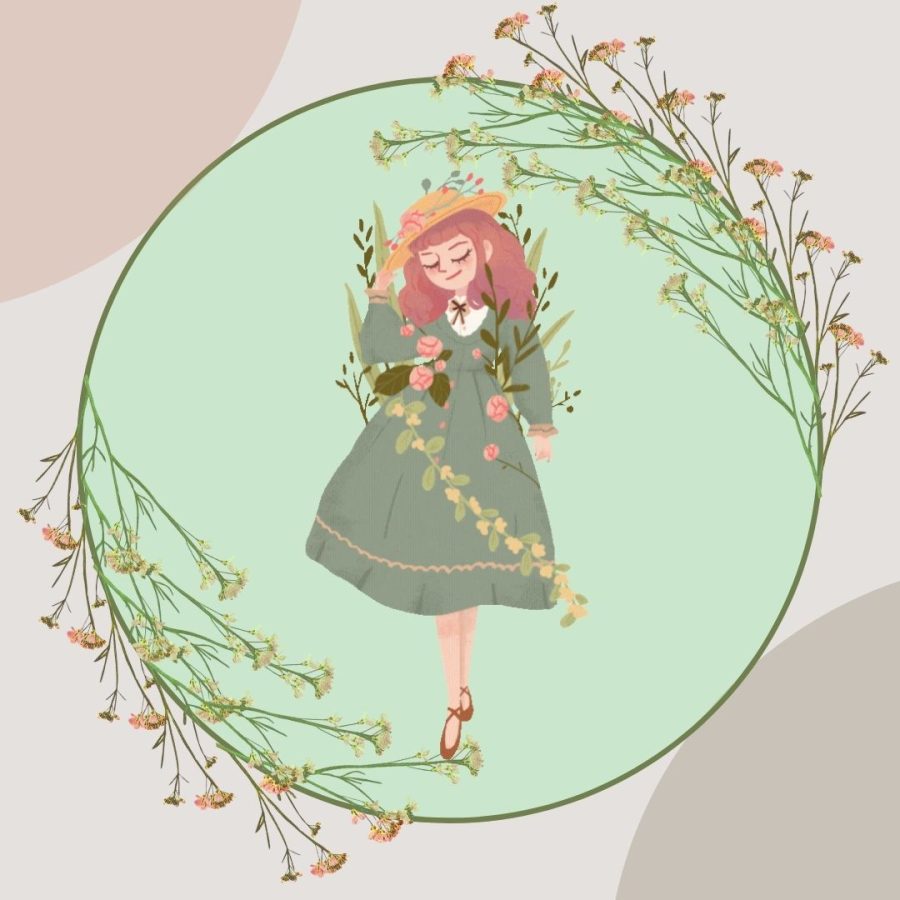Taking care of plants impacts mental health
Kimberly Lopez (created with Canva)
Taking care of plants and gardening can be escapism for some.
Everyday we interact with plants. There are trees, bushes, and flowers all around us. You step outside of your home and immediately see palm trees, clovers, and flowers. However, owning plants and taking care of them can bring us a great sense of joy and pride. Gardening and taking care of plants can be an escape from reality for some.
Senior Gil Lopez said, “Plants help me take a breather and relax. It takes the stress of school and my personal life away temporarily as I water them, trim their leaves or replace flowers from the family altar. They’re just a great way to keep me calm during my spare time.”
Taking care of plants can help people find peace in their everyday life.
Counselor Arlene Quinonez said, “I feel that it opens up my home and that it’s my safe space. Even when I go outside there are plants. Just seeing the greenery helps me. I think that plants, especially when you see them grow, give you a specific example.”
Quinonez described a plant that is meaningful to her.
She said, “I have this little plant that I got from the swap-meet and it was small when I got it; it was only 50 cents. Sometimes those dollar plants die fast like the ones at the 99 Cents Only stores. I was like ‘this isn’t going to happen to my plant.’ I put it into my little pot, I gave it soil and water, and I want to say in about two weeks I started to see it expand and in another few weeks, it started to expand to the ceiling.”
When taking care of plants, people can forget about life for a while.
Keith Hinckley said, “I think the biggest thing is that it gives you a way out from the challenges of life, the struggles, and the difficulties and you can think about something else. You don’t worry about paying bills, where you have to be, or what phone calls you have to make.”
Keeping a schedule centered around gardening can help improve time management.
Lopez said, “Sometimes I get too lazy to get groceries or make food, but plants allow me to improve on following through with myself by having scheduled times to tend to them, move them from/into the sun, water them, trim them, etc. I think plants occupy a mental state in one’s mind in the same way sports, reading, and getting a pet, help people get into a state of mind where worries fly out the wind. Maybe not temporarily or severely, but they’re still beneficial to some in aiding with struggles.”
Picking up gardening as a hobby can be intimidating because of the research required. Topics that you need to understand include how much you need to water, the different types of soil, different uses of soil, when to cut a plant, and when you should do certain things. You also need to know how sunlight, temperatures, and humidity affect plants.
Some easy plants to start with include pothos, succulents, marigolds, ZZ plants, and snake plants.
Pothos also known as Devil’s Ivy is one of the easiest household plants to take care of. It thrives in indirect sunlight and it needs water every two days.
Succulents need to be moved every five hours. They should be in the sun for five hours and then moved to be in the shade. Succulents need to be watered once a month to prevent rot. After the soil is completely dried, then they can be watered again.
Marigolds are good outdoor plants. They need a lot of sunlight and need to be watered twice a week. In hot weather they need to be watered more often.
ZZ plants thrive in dimly lit environments. They don’t require a lot of sunlight. Just like succulents they need to be watered once every month to prevent rot. It should be moved to a normal lit area two days out of a month and it should be moved to a brightly lit area three times a month.
Snake plants do good in any lighting, especially bright light. They need to be watered once a month and can be watered again once the soil is completely dry.
Lopez said, “I recommend a succulent plant as they’re affordable, attainable, and often don’t require much. It’s exciting to learn how resilient these plants can be and it can motivate people to continue improving on managing more sensitive plants like ferns or flowers.”
El Salvador Park Community Garden is a great place to start gardening while reaching out to the community. They host events such as El Salvador Park Community Garden hosts events such as the Harvest Festival, International Composting Week, Volunteer Days, Bed Building Days, and World Soil Day.
The Harvest Festival is a free event where the community can decorate pumpkins and garden. This year it is happening on October 28 from 4 p.m. to 6 p.m.
Santa Ana community garden director Veronica De Vol Roach said, “They sequester carbon, improve air quality, and create enjoyable green spaces. They provide habitats and contribute to the balance of all living things. Working with plants and putting my hands in the soil connects me to nature and gets me outdoors. I’ve always loved being outside. Plants help me zone out while I am weeding a garden patch or trimming plants, but they also provide a sense of accomplishment. It is pretty meaningful to be part of the process of growing vegetables and fruits from seeds.”
Community gardens are a great place to learn and adopt plants that are unfamiliar to you. Gardening is a skill you learn and work hard at, although it can take a long time to master, there are so many plants to learn about.
De Vol Roach said, “After college, I started volunteering at a community garden and working for an Outdoor Education Center. Connecting to nature improves my mood and alleviates anxieties. Seeing and being around plants helps people feel calmer and more relaxed. Research shows green spaces improve overall well-being, reduce symptoms of depression, reduce stress, and contribute to greater quality of life.”
There are many places to get plants such as grocery stores, discount stores, and hardware stores. Plants found at these places are more expensive which can turn people away from the hobby. Inexpensive plants can be found at swap-meets, nurseries, and community gardens.
Restoration designer and landscape architect Marina French said, “The basic biology that influences the cost of a plant is its age and how easy it is to grow and reproduce.”
The cost of a plant depends on the time and effort spent on its growth. Fully grown plants can take years to produce which makes them more expensive.
French said, “However, depending on the species and growth rate, you may find massive plants for a teeny price because they grow fast or teeny plants with a massive price tag because they grow very slowly. You are paying for time but if you need immediate results, go big.”
Purchasing at least three plants makes it possible to create a beautiful yet inexpensive garden.
TikToker @Brandonkoruna said, “If you want your gardens to look fuller and want to do it cheaply these are the perennial plants you want to get anyway. Number one is hostas; they are super robust, and they’ll grow almost anywhere. And every year you can just chop them in half and split them, and they will also flower. And iris, they flower in late spring and every year I chop them in half and plant the extra half somewhere else or give it away. Finally, the black-eyes Susan grows big and vigorous and can split every year.”
Expensive plants take years to grow. Factors that make plants expensive are the rate that it grows, how beautiful the plant is if it propagates well, and how fast it reproduces. Researchers can take years to create and grow a unique plant.
For people who want to take this hobby to the next step, there are training programs where one can become a master gardener.
A certified master gardener Marijke Puts said, “Shenzhen Nongke Orchid is a manufactured plant that took eight years to develop. The plant originated in a university lab with a price tag of $200,000.”
In gardening, there are ups and downs. People learn from their mistakes to become better for future plants.
Quinonez said, “I had started with houseplants and I felt guilty because I would kill them so easily. My mom told me to start with succulents and that I couldn’t kill succulents and reassured me that she will help me through the process. My mint plant is overgrown all over my yard and I have to try at least to cut and stop their growth.”
Seeing plants grow can help us feel motivated in our own life. This motivation can be seen in our performance at work and school along with how we interact socially.
Quinonez said, “It makes me happy to see that growth, and I relate to the plant. ‘Give me a little sunlight’ and ‘give me a little bit of water when I’m thirsty’ and the same for my students. Give you guys the resources you need so that we can all flourish. I like to see the growth of my plants to see them flourish but also meet their needs like a little water and sun. It makes me feel happy that I am providing for their growth.”

Obsessed with the band Lovejoy, I love Iced coffee, I have a fish named Tortilla.












